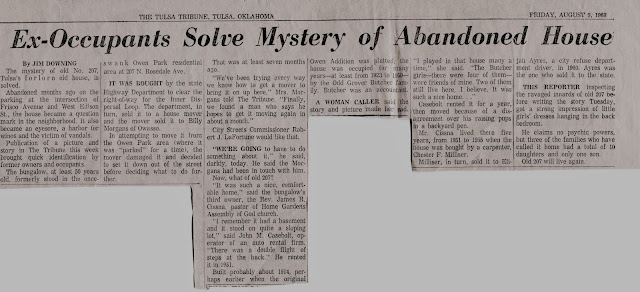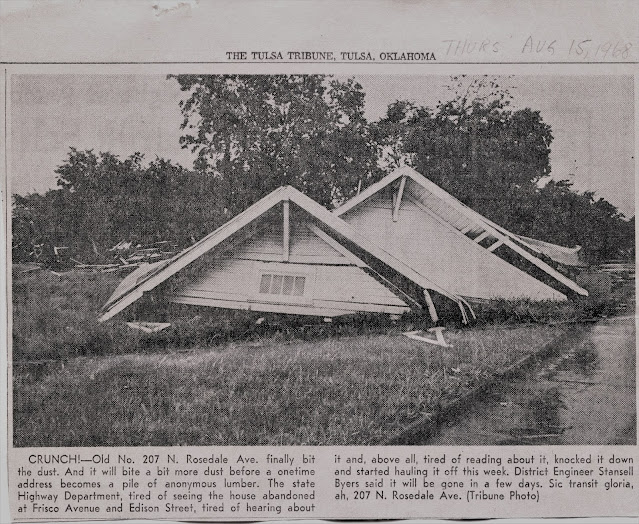Obituary of a house.
By P. Casey Morgan
My friend, Arena Mueller, writes house histories – intriguing stories that include past residents, original owners of the land, years of construction, unusual features and vintage fixtures. She weaves tales of candy store proprietors and brothel owners, of soldiers and bootleggers, of schoolteachers and juvenile delinquents. The ordinary looking house you drive by every day suddenly looks mysterious when you read descriptions of the locked drugstore safe in the basement or the 1940s time capsule found in the chimney by the current owners. She makes these places come alive.
This is a story about a house that is dead.
When I was growing up, my parents read both newspapers every day – The Tulsa World in the morning and The Tulsa Tribune in the evening. One August night when I was fifteen, my father (who usually read the paper without comment), said, “Hey! Honey, look – it’s our old house on Rosedale.” Mom and I leaned over his shoulder to look at a picture of a house under the headline, “Abandoned City House – Where Did It Come From?” A house in the process of being moved was dumped near Owen Park, north of downtown Tulsa. It had apparently been sitting there for many months. The story noted that the house number was 207, but 207 on what street? Nor was it known who the house belonged to, who had abandoned it, or why. My parents told me they had rented the house a few years before I was born.
 |
| My parents as they looked around the time they lived in the house |
Running the Tribune story with a picture solved the mystery. The next day, a follow-up (now bylined by Jim Downing) included the proper address of the house before it had been uprooted – 207 North Rosedale, in the Owen Park neighborhood (sadly referred to as “the once swank Owen Park residential area.”) Several former residents, including my father, had contacted the paper with information about the house. A woman remembered playing in the house as a child with the four daughters who lived there. My father described a sloping lot and a dispute with the landlord around raising puppies in the backyard (I realize now that it must have been the puppies of the fabled “Puddin’ and Suzy,” dogs I heard stories about growing up but who were gone before I entered the scene.) A minister remembered a pleasant home.
Meanwhile, the poignant memories of the former residents contrasted with the story of how the house ended up kicked to the curb. The highway department had bought the home to clear the way for the Inter-Dispersal Loop and sold it to a house mover, who sold it to a man in Owasso. The mover got the house from Rosedale to the corner of Frisco and Edison (less than a mile away), developed problems, dumped the house, H-beams still underneath it, and skedaddled.
In the days that this story took place, August of 1968, a man named Robert J. LaFortune (later mayor himself and grandfather of our current mayor) was Tulsa’s Streets Commissioner. His are my favorite quotes in the newspaper stories (sorry, Dad). In the first story about the unidentified house: “ ‘You mean it has been sitting there for months?’ demanded Robert J. LaFortune, commissioner of streets and public property.” The second story identifies the Owasso couple who bought the house and who had been trying in vain to find a mover, any mover, to pick it up and bring it to them, and notes that they had now been in touch with the commissioner. LaFortune’s response: “‘We’re going to have to do something about it,’ he said, darkly, today.”
When’s the last time you saw the word “darkly” in a newspaper article, describing someone’s speaking tone? You imagine him hanging up the phone and opening his bottom desk drawer, reaching for the bourbon, like a 1940s detective in a bad novel.
The first article had a number of fanciful suppositions about families celebrating Thanksgiving in the bay-windowed dining room and dresses hanging in the bedroom closet. The second article came back to that point saying, “This reporter inspecting the ravaged innards of old 207 before writing the story Tuesday, got a strong impression of little girls’ dresses hanging in the back bedroom. He claims no psychic powers, but three of the families who have called it home had a total of 10 daughters and only one son.” That son was my brother.
Sadly, the third installment in the tale wasn’t an article at all - just a picture and a cutline – the porch roof of the house sitting on the ground, a week after the first article. I’ve seldom seen such a lively caption in a daily newspaper so I’m quoting it here in its entirety: “CRUNCH! – Old No. 207 N. Rosedale Ave. finally bit the dust. And it will bite a bit more dust before a onetime address becomes a pile of anonymous lumber. The state Highway Department, tired of seeing the house abandoned at Frisco Avenue and Edison Street, tired of hearing about it and, above all, tired of reading about it, knocked it down and started hauling it off this week. District Engineer Stansell Byers said it will be gone in a few days. Sic transit gloria, ah, 207 No. Rosedale.”
This begs the question of how the Highway Department had the right to demolish a house that no longer belonged to them but I imagine the statute of limitations has long run out on that. Alert readers who read the attached newspaper clippings will remember that unusual name “Stansell Byers” from the first article, when he was denying the house was owned by his department, essentially saying, “Nope. Not ours. I’ve never seen that house before.” A week later, he’s sweeping up the remains.
I had to look it up: “Sic transit gloria” is Latin for “thus passes worldly glory.” Kind of a hifalutin’ phrase for the demolition of a house but kind of sweet, too. And, again, when’s the last time you saw a Latin phrase in a newspaper?
My parents only lived in the house for a year, then another year in a rental (also now demolished) near The University of Tulsa before buying a house near 49th and Peoria that they would own for fifty-eight years. My own family lives in the Renaissance neighborhood. I have no real connection to Owen Park, other than having friends who live there, but I admire their vigorous neighborhood association, the beautiful and varied historic homes and the lively, eclectic spirit that pervades the area. I’m not sure if they are lucky enough to have a neighborhood historian as we do in Renaissance (the aforementioned Arena Mueller), but I wanted them to have this little bit of missing history.
Let’s all say it together: “Sic transit gloria, ah, 207 No. Rosedale.”
 |
| My older sister, Sugarfoot, and brother, Mike, in front of 207 N. Rosedale in 1951. |
Written by P. Casey Morgan
Editing by A. Mueller and A. Brammer



There is a lot of history in that neighborhood. One of my favorites is what looked like a plack near a tree on the street leaving the recreation center to the North. The point where the properties of 3 Indian tribes came together.
ReplyDeleteAnd of course there is the dynamite that created the pond on the SW side of the park. Just the start of the stories.